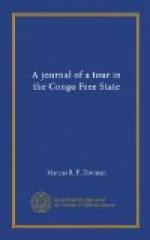As our house looks into the square where the Force Publique drill, we witness the methods employed. At first the recruit is taught which is right and which is left. Droite and up goes the right hand, gauche and the left follows. The native corporal, however, has corrupted these words into hi hoo so that, as is usual in military commands, no mere civilian can possibly understand them. Afterwards when he comes to mount guard and relieve sentries, the order presentez armes! might be anything from the sound.
The band practices also close at hand. First the cornet picks out some air he has heard, note by note, and like a child who is learning the piano, always goes back to the beginning of the piece when he strikes a false note. After many trials the whole air is discovered. Then the trombones and bass instruments put in the accompaniment also by experiment, and in the end the result is really quite good for Africans unlike Asiatics, take kindly to European music.
The method of moving heavy weights is necessarily very primitive, for, with the exception of a few wheel-barrows, there are no vehicles of any kind here. A huge tree trunk was carried into the square one day; pieces of wood had been lashed across it about two feet apart throughout its length. One or two men on each side of each piece then lifted it and the whole eighty or hundred men marched the trunk along with ease at a jog trot. It would indeed be impossible to use heavy trolleys in this part of the Congo, for the roads are sandy and the wheels would at once sink deeply into them.
A walk through the plantation, which extends over some square miles, is very pleasant, as the palms spread their leaves across the avenues until they nearly touch each other thus forming beautiful shady groves. Ferns grow round the stems and the whole is extremely pretty and cool-looking. Beyond the plantation is the cemetery for the whites. Each grave is covered with bricks and has a wooden cross at the head on which is inscribed the name and date of death. The age however, is omitted and this is perhaps as well, for the Congo exacts a heavy toll of young lives and new comers are often depressed already by the accounts of the climate which have reached Europe.




